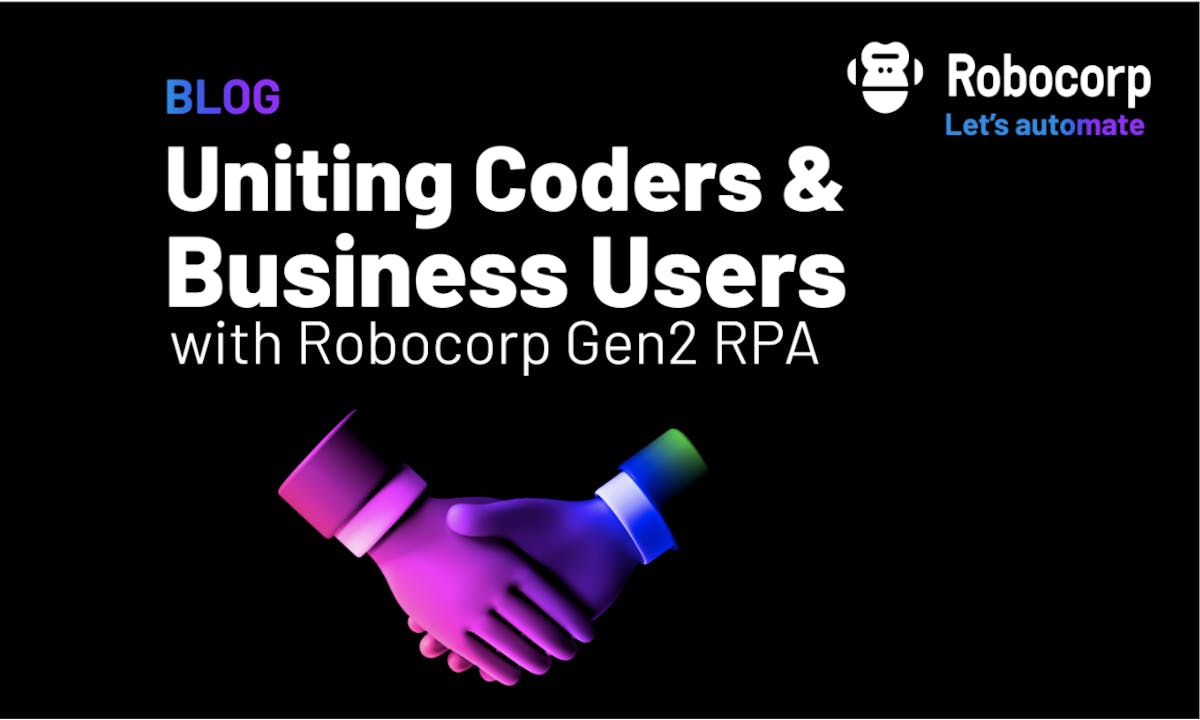
Uniting Coders and Business Users in One Collaborative Environment
August 24, 2022 – Dave Dabbah, CMO
Having worked in and around the automation space for over 20 years, I was excited to experience Robocorp’s public beta release of Automation Studio, which is part of our company's more extensive Gen2 RPA offering. The solution is branded as “Automation for Everyone,” and while that might sound like a big promise, this solution delivers for both developers and business users.
What is Automation Studio?
In a nutshell, Automation Studio is an integrated development environment (IDE) designed to give RPA creators the option between code and low-code experiences. It allows users to build bots in a modern and efficient Code Editor but also lets business users create them in a drag-and-drop Visual Editor - all within one desktop application.
Python is under the hood.
Automation Studio is powered by Robot Framework - a Python-based open-source automation framework. In its early days, the framework was created by a community of software testers that needed efficient ways to automate software testing to make sure code worked as planned. Over time, the community grew, and the library of automations became an exchange for thousands of developers that needed reliable ways to test mission-critical applications.
Several active community members then realized the power of Robot Framework could be applied to RPA use cases, but at a fraction of the cost and with better performance than many of the UI-based solutions on the market. This became the genesis of Robocorp’s founding, which turned into “Gen2 RPA” which comes with a wide range of advantages over other platforms.
Why does Automation Studio matter?
First, it's a single IDE with dual editors for developers and business users, which is rare in this industry. You can debug and run bots directly from Automation Studio or import the portable robot files into the orchestrator of your choice.
Business users can drag and drop functional building blocks in the Visual Editor to construct bots, and code is then dynamically generated in the Code Editor. From a developer’s perspective, they can build bots in the same solution as their business colleagues but have granular control over the creation process.
At the same time, business users can learn coding basics and collaborate with their dev teams. This collaboration makes it possible for developers to quickly determine specific business requirements laid out by business users.
Automation Studio offers conversion tooling so current users of Blue Prism, Automation 360, and soon UI Path can ease the migration process from these Gen1 vendors to Robocorp’s Gen2 RPA platform.
Most importantly, Automation Studio’s flexible Python code lets users automate virtually any business process across any technology. In addition, it works deeper within application layers than other solutions, so bots don’t break as frequently and disrupt operations.
Conclusion
Robocorp was built by engineers to help automation creators eliminate broken bots that cause frustration and lost time. Our Gen2 RPA platform offers flexible open-source development tools and cloud-native orchestration to help citizens and professional developers quickly and securely build and implement sustainable digital workers across your organization.
The interesting thing about Automation Studio is how it brings business users and developers together in one IDE to automate common scenarios that might be right for your use cases. If business users want to use Automation Studio but professional coders don’t, that’s fine. The robot files can be opened and edited in VS Code or the developer’s favorite editor.
It's worth checking out and exploring your automation possibilities. Robocorp is great at listening to its users and incorporating feedback into continuous releases. Their team will add new libraries, keywords, and other features shortly. Check it out!